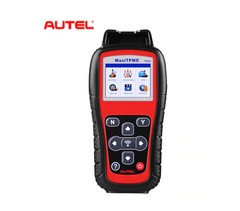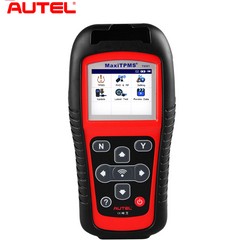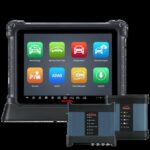Is your automotive shop seeking a reliable TPMS tool? CARDIAGTECH.NET presents a comprehensive comparison of the Autel TS501 and TS508, empowering you to make an informed decision. We’ll dissect their features, benefits, and drawbacks to help you select the perfect tool for your needs. Discover the advantages of advanced automotive diagnostics with CARDIAGTECH.NET, featuring comprehensive vehicle coverage, sensor activation capabilities, and user-friendly interfaces.
1. Decoding TPMS and Why You Need a Reliable Tool
Tire Pressure Monitoring Systems (TPMS) are crucial for modern vehicles. They provide real-time tire pressure data, alerting drivers to potential issues like underinflation or punctures. Maintaining proper tire pressure improves fuel efficiency, extends tire life, and enhances vehicle safety. According to the National Highway Traffic Safety Administration (NHTSA), underinflated tires are a significant factor in vehicle accidents. A reliable TPMS tool is indispensable for any automotive technician or DIY enthusiast.
2. Autel: A Leader in Automotive Diagnostic Solutions
Autel stands as a global leader in automotive diagnostic tools and TPMS solutions. They provide a broad spectrum of products, from basic OBDII code readers to sophisticated diagnostic and analysis systems. Autel’s commitment to innovation and quality makes them a trusted brand among automotive professionals worldwide. They also offer a full range of TPMS solutions, featuring full-featured TPMS diagnostic tools and general programmable OE replacement sensors.
3. Diving Deep: Autel TS501 vs TS508 – A Detailed Comparison
Let’s delve into the specifics of the Autel TS501 and TS508, highlighting their key differences and similarities. This in-depth comparison will provide you with the knowledge needed to choose the right tool for your specific requirements.
3.1. Autel TS501 vs TS508: At-a-Glance
| Feature | Autel TS508 | Autel TS501 |
|---|---|---|
| Price (Approximate) | $235.00 | $198.00 |
| Battery Capacity | 3200 mAh | 2400 mAh |
| Operating Modes | Quick Mode & Advanced Mode | Advanced Mode Only |
| Tire Type/Pressure Selection | Yes | No |
| Update Method | USB | SD Card |
| Special Features | Quick Mode for faster TPMS service, Tire Type/Pressure Selection for accurate adjustments | OBDII connectivity for relearn procedures |
| Sensor Activation | Activates all known TPMS sensors | Activates all known TPMS sensors |
| Data Reading & Clearing | Reads sensor data, clears TPMS DTCs | Reads sensor data, clears TPMS DTCs |
| MX-Sensor Programming | Auto ID creation, Manual OE ID input, OBD ID copy | Auto ID creation, Manual OE ID input, OBD ID copy |
| Relearn Procedure Guide | On-screen guide | On-screen guide |
| Key Fob Check | Yes | Yes |
| Warranty | One-year limited warranty | One-year limited warranty |



3.2. Power and Performance: Battery Life
The TS508 boasts a 3200 mAh battery, while the TS501 has a 2400 mAh battery. This translates to longer operating time for the TS508, making it ideal for busy shops where technicians need a tool that can last throughout the day without frequent charging.
3.3. Functionality: Quick Mode vs Advanced Mode
The Autel TS508 distinguishes itself with its Quick Mode and Advanced Mode functionalities. Quick Mode simplifies basic TPMS tasks, saving time on routine checks and sensor programming. Advanced Mode unlocks the full spectrum of features for comprehensive diagnostics and in-depth analysis. The TS501 offers only the advanced mode.
3.4. Software Updates: USB vs SD Card
Updating the software on these devices is also different. The TS508 uses a USB connection for updates, while the TS501 utilizes an SD card. USB updates are generally faster and more convenient, while SD cards offer portability and can be useful in areas with limited internet connectivity.
3.5. Display and Design Considerations
Both the Autel TS501 and TS508 share the same user-friendly TFT color display (320 x 240 dpi), providing clear and easily readable data. They also share a rugged design, built to withstand the rigors of a shop environment.
4. Autel MaxiTPMS TS508: The Flagship TPMS Diagnostic & Service Tool
The Autel MaxiTPMS TS508 is a comprehensive tool designed to activate all known TPMS sensors, read sensor status, assess TPMS system health, program MX sensors, and execute TPMS relearning procedures.
4.1. Two Modes for Efficient TPMS Service
The TS508 provides two service modes:
- Quick Mode: Streamlines basic TPMS functions for fast sensor checks and MX sensor programming.
- Advanced Mode: Offers complete TPMS functionality, including sensor checks, TPMS diagnostics, MX sensor programming, and sensor location relearning.
4.2. TPMS Status Screen: A Complete Overview
The TS508’s dedicated TPMS status screen provides a wealth of information, including:
- ECU sensor ID reading.
- Sensor ID and ECU ID matching verification.
- DTC reading and clearing.
- Detailed DTC descriptions.
- Four MX-sensor programming options: Activate replication, Manual input and copy, Automatic creation 1-16, and Copy by OBD.
4.3. Pros and Cons of the Autel MaxiTPMS TS508
| Pros | Cons |
|---|---|
| Complete Functionality, Easy to Carry, Long Battery Life | Requires checking compatibility lists, Custom battery may be harder to replace |
| Simple to Operate, Free Lifetime Updates, Quick Mode for Efficiency |
5. Autel MaxiTPMS TS501: A Reliable and Affordable Solution
The Autel MaxiTPMS TS501 is a versatile TPMS tool designed for diagnosing TPMS issues, activating OEM/universal TPMS sensors, cloning sensor IDs, reprogramming sensors to the vehicle’s ECU, and turning off warning lights.
5.1. TPMS Status Screen: All Information at a Glance
The TS501’s single-screen organization allows you to easily view direct feedback from all four sensors, understand the status of all TPMS functions, compare sensor and ECU data, and identify system faults.
5.2. User-Friendly Software Operation
The TS501 features an intuitive software interface. Simply follow the program options and on-screen instructions for sensor activation or diagnostic functions.
5.3. OBDII Connectivity for Advanced Functionality
The TS501 connects to the vehicle’s ECU via an OBDII cable, enabling sensor relearning, ID cloning, automatic ID creation, and manual sensor ID writing.
5.4. Pros and Cons of the Autel MaxiTPMS TS501
| Pros | Cons |
|---|---|
| Easy to Use, Supports OBD2 Connection, Affordable Price, Reliable Performance | Primarily for Autel sensors, Requires checking compatibility lists, Custom battery may be harder to replace |
6. Making the Right Choice: Factors to Consider
Choosing between the Autel TS501 and TS508 depends on your specific needs and budget. Here’s a breakdown to help you decide:
- Budget: The TS501 is the more affordable option.
- Functionality: The TS508 offers Quick Mode and Tire Type/Pressure Selection, making it more versatile for a wider range of TPMS tasks.
- Battery Life: The TS508’s larger battery provides longer operating time.
- Update Method: Consider your preference for USB or SD card updates.
7. Real-World Scenarios: Which Tool Excels?
- High-Volume Shop: The TS508’s Quick Mode and longer battery life make it ideal for busy shops that need to perform TPMS services quickly and efficiently.
- Mobile Technician: Both tools are portable and suitable for mobile technicians.
- DIY Enthusiast: The TS501 offers a good balance of functionality and affordability for DIYers.
8. TPMS Tools: Enhancing Efficiency and Profitability
Investing in a quality TPMS tool like the Autel TS501 or TS508 can significantly improve your shop’s efficiency and profitability. By quickly and accurately diagnosing and resolving TPMS issues, you can reduce repair times, increase customer satisfaction, and boost your bottom line.
9. CARDIAGTECH.NET: Your Partner in Automotive Diagnostics
At CARDIAGTECH.NET, we understand the challenges faced by automotive technicians. We offer a comprehensive selection of diagnostic tools, including the Autel TS501 and TS508, to help you streamline your workflow, improve accuracy, and enhance your service offerings. Contact us today to learn more about how our tools can benefit your business.
10. Addressing Customer Challenges with CARDIAGTECH.NET
We understand the challenges faced by automotive professionals. The work can be physically demanding, with constant exposure to grease and chemicals. Staying current with ever-evolving automotive technology is crucial. Pressure to meet deadlines and competition from other garages adds to the stress. Finding the right, high-quality tools can be difficult.
CARDIAGTECH.NET offers solutions to these challenges by:
- Providing efficient tools to reduce repair times: The Autel TS501 and TS508 streamline TPMS diagnostics and repairs.
- Enhancing accuracy and safety: Precise readings and guided procedures minimize errors.
- Offering cost-effective solutions: Save money for your customers through accurate diagnostics and efficient repairs.
- Boosting garage revenue: Increase customer satisfaction and repeat business.
- Elevating your garage’s reputation: Provide top-notch service with the best tools.
Ready to elevate your automotive service capabilities? Contact CARDIAGTECH.NET today for expert guidance on selecting the perfect TPMS tool for your needs. Let us help you overcome your challenges and achieve greater success.
Address: 276 Reock St, City of Orange, NJ 07050, United States
WhatsApp: +1 (641) 206-8880
Website: CARDIAGTECH.NET
11. Navigating the World of TPMS Relearn Procedures
TPMS relearn procedures are necessary when replacing sensors or rotating tires. Each sensor has a unique ID that needs to be registered in the vehicle’s TPMS module. There are three main types of relearn procedures:
- Auto Relearn: Requires driving the vehicle at a specific speed and time.
- OBD Relearn: Connects the TPMS tool to the vehicle’s OBD port to write the sensor ID into the ECU.
- Stationary Relearn: Allows relearning the sensor ID without driving the vehicle or writing the ID into the TPMS module.
12. Essential TPMS Definitions
Understanding common TPMS terminology is crucial for effective diagnostics and repairs. Here are some key definitions:
- TPMS: Tire Pressure Monitoring System
- DTC: Diagnostic Trouble Code
- ECU: Engine Control Unit
- OBDII: On-Board Diagnostics II
- MX-Sensor: Autel’s programmable TPMS sensor
13. Choosing the Right TPMS Sensor: OEM vs Aftermarket
When replacing TPMS sensors, you have the option of using OEM (Original Equipment Manufacturer) sensors or aftermarket sensors. OEM sensors are typically more expensive but are guaranteed to be compatible with the vehicle. Aftermarket sensors, like Autel’s MX-Sensors, offer a more affordable alternative and can often be programmed to work with a wide range of vehicles.
14. Maintaining Your TPMS Tool for Optimal Performance
Proper maintenance is essential for ensuring the longevity and accuracy of your TPMS tool. Here are some tips:
- Keep the tool clean and dry.
- Store the tool in a safe place when not in use.
- Update the software regularly.
- Replace the battery when necessary.
15. Demystifying Direct vs. Indirect TPMS
Understanding the difference between direct and indirect TPMS is essential for proper diagnosis and repair.
- Direct TPMS: Uses sensors in each wheel to directly measure tire pressure.
- Indirect TPMS: Uses the vehicle’s ABS sensors to estimate tire pressure.
16. The Future of TPMS Technology
TPMS technology is constantly evolving. Future advancements may include more sophisticated sensors, wireless communication capabilities, and integration with other vehicle systems. Staying informed about these advancements will be crucial for automotive professionals.
17. TPMS and Vehicle Safety: A Critical Connection
TPMS plays a vital role in vehicle safety. By alerting drivers to low tire pressure, TPMS helps prevent accidents caused by tire failure. Maintaining a properly functioning TPMS system is crucial for ensuring the safety of your customers and their vehicles.
18. Understanding TPMS Regulations and Compliance
In many countries, TPMS is mandatory on all new vehicles. Automotive professionals need to be aware of these regulations and ensure that they are complying with all applicable laws.
19. Troubleshooting Common TPMS Problems
Here are some common TPMS problems and troubleshooting tips:
- Low tire pressure warning light: Check tire pressure and inflate to the correct level.
- Faulty sensor: Replace the sensor.
- Communication issues: Check the wiring and connections.
- ECU problems: Diagnose and repair the ECU.
20. Optimizing Tire Pressure for Fuel Efficiency
Maintaining proper tire pressure not only improves safety but also enhances fuel efficiency. According to the U.S. Department of Energy, underinflated tires can reduce fuel economy by up to 3%.
21. Decoding TPMS DTCs: A Technician’s Guide
TPMS DTCs (Diagnostic Trouble Codes) provide valuable information about the nature of the problem. Understanding these codes is essential for accurate diagnosis and repair. Refer to the vehicle’s service manual or a TPMS diagnostic tool for a complete list of DTCs and their descriptions.
22. Advanced TPMS Diagnostics: Beyond the Basics
For complex TPMS issues, advanced diagnostic techniques may be required. These techniques may include using an oscilloscope to analyze sensor signals or performing a system-level scan to identify underlying problems.
23. The Importance of Regular TPMS Inspections
Regular TPMS inspections are crucial for preventing problems and ensuring the system is functioning correctly. During an inspection, check the sensors for damage, verify the tire pressure, and scan for DTCs.
24. TPMS and Tire Rotation: Best Practices
When rotating tires, it’s important to relearn the TPMS sensors to ensure the system is accurately monitoring tire pressure. Follow the vehicle manufacturer’s recommended relearn procedure.
25. The Impact of TPMS on Tire Wear
Properly inflated tires wear more evenly, extending their lifespan. TPMS helps prevent uneven wear by alerting drivers to low tire pressure, allowing them to take corrective action.
26. Programming Autel MX-Sensors: A Step-by-Step Guide
Programming Autel MX-Sensors is a straightforward process. Follow these steps:
- Select the vehicle make, model, and year in the TPMS tool.
- Choose the appropriate sensor programming method.
- Follow the on-screen instructions to program the sensor.
- Install the sensor in the wheel.
- Perform a TPMS relearn procedure.
27. Ensuring TPMS Sensor Compatibility
Before replacing a TPMS sensor, it’s essential to ensure it is compatible with the vehicle. Consult the vehicle’s service manual or a TPMS compatibility guide to identify the correct sensor for the application.
28. TPMS and Winter Tires: What You Need to Know
When installing winter tires, it’s important to transfer the TPMS sensors from the original wheels to the winter wheels or install new sensors. The TPMS system will need to be relearned after the winter tires are installed.
29. Advanced Tips for Working with TPMS Tools
- Always update the tool’s software to the latest version.
- Use the correct OBDII cable for the vehicle.
- Follow the on-screen instructions carefully.
- Consult the vehicle’s service manual for specific TPMS information.
30. TPMS Sensor Battery Life: What to Expect
TPMS sensor batteries typically last for 5-10 years. Factors that can affect battery life include the operating temperature, the number of miles driven, and the frequency of TPMS activations.
31. Understanding TPMS Sensor Frequencies
TPMS sensors operate on specific radio frequencies. It’s important to use sensors that are compatible with the vehicle’s TPMS system frequency.
32. The Role of TPMS in Autonomous Vehicles
As autonomous vehicles become more prevalent, TPMS will play an increasingly important role in ensuring safe and reliable operation. TPMS data can be used to optimize vehicle performance and prevent accidents.
33. The Future of TPMS Repair and Service
The TPMS repair and service market is expected to continue to grow in the coming years. Automotive professionals who invest in the right tools and training will be well-positioned to capitalize on this growth.
34. Maximizing Your Return on Investment with TPMS Tools
To maximize your return on investment with TPMS tools, focus on providing high-quality TPMS services, promoting your services to customers, and staying up-to-date on the latest TPMS technology.
35. FAQ
Q: How do I distinguish between indirect TPMS and direct TPMS?
Direct TPMS uses tire pressure sensors on each wheel to measure tire pressure. Indirect TPMS relies on the vehicle’s ABS system to estimate tire pressure based on wheel speed.
Q: How can I ensure that my vehicle has a direct TPMS sensor?
Consult your Autel tool. Select the vehicle’s make, model, and year. The tool will indicate whether the vehicle’s TPMS is direct (sensor-equipped) or indirect (sensor-free). Direct TPMS sensors typically have a rubber or metal stem.
Q: What does it mean to relearn TPMS sensors? When is it necessary, and how is it done?
Each TPMS sensor has a unique ID registered in the vehicle’s TPMS module. Relearning is required when replacing sensors or rotating tires. There are three relearning methods:
- Auto Relearn: Driving the vehicle at a specific speed and time.
- OBD Relearn: Connecting a TPMS tool to the OBD port to write the sensor ID into the ECU.
- Stationary Relearn: Relearning the sensor ID without driving or writing to the TPMS module.
Q: Can I program other brands (Dorman or Schrader) or only Autel MX sensors?
Autel TPMS tools are primarily designed to program Autel MX sensors. While some tools may offer limited compatibility with other brands, optimal performance is guaranteed with Autel sensors.
Q: What are the latest updates regarding Autel TPMS tools and sensor programming methods?
The US version of Autel TPMS tools has discontinued two sensor programming methods in August: Copy by Activation and Copy by manual input. However, TS501 and TS508 support OBD learning, minimizing the impact.
Investing in a quality TPMS tool like the Autel TS501 or TS508 from CARDIAGTECH.NET can significantly improve your shop’s efficiency and profitability. By quickly and accurately diagnosing and resolving TPMS issues, you can reduce repair times, increase customer satisfaction, and boost your bottom line. Contact CARDIAGTECH.NET today to learn more about how our tools can benefit your business.

